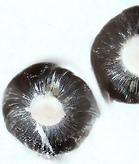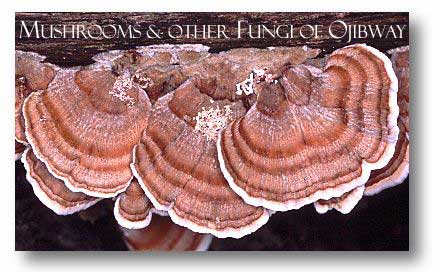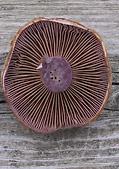|
MYXOMYCETES
|
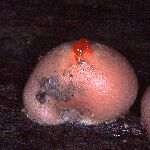
|
Wolf's-milk (or Toothpaste) Slime, Lycogala epidendrum These small pink balls are often found on large rotten logs at Ojibway. Slime moulds are not considered true fungi. Their fruiting bodies resemble fungi but at other stages in their life they act more like animals, moving through rotten wood eating bacteria, spores and other organic matter.
|
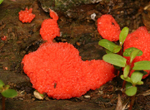
|
Red Raspberry Slime, Tubifera ferruginosa When clustered together this slime mould closely resembles a red raspberry. After maturing it will turn brown, this is often called the “cigar” stage.
Photographed at Ojibway on June 14, 2007 by Tom Preney.
|
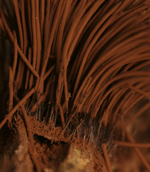
|
Chocolate Tube Slime, Stemonitis splendens This hair-like cinnamon coloured slime mould is found on decaying wood and leaf litter throughout the park.
Photographed at Ojibway on September 17, 2009 by Tom Preney.
|
|
ZYGOMYCETES
|
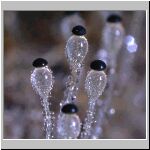
|
Pilobolus (literally "cap thrower"), Pilobolus cf. umbonatus Many fungi specialize in feeding on unusual food resources such as pollen or caterpillars. This tiny coprophilic fungus can be found on fresh horse droppings. The black spore caps are "blasted" away from the manure and stick to a blade of grass to await another horse to eat the spores.
|
|
ASCOMYCETES
|
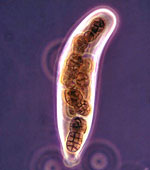
|
ascus and spores Pleospora sp. Ascomycetes produce their spores in a sac called an "ascus" and each ascus contains eight ascospores. This species produces tiny dark fruiting bodies on the surface of dead wood.
Photographed through a phase contrast microscope by Paul Pratt.
|
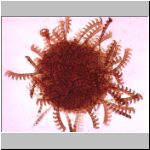
|
Arthroderma Arthroderma sp. Arthroderma is one of the few fungi that can utilize feathers as a food source. This microscopic spore mass is designed to snag on a bird's feathers.
|
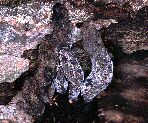
|
Dead Man's Fingers Xylaria cf. polymorpha These club- or finger-shaped fruiting bodies grow about 5 to 8 cm tall. They are black and hard on the outside with a tough whitish interior (stroma). Look for them on old maple or beech logs.
|
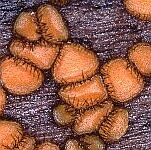
|
Pixie Cup Scutellinia setosa These small (2 cm) cup fungi can be identified by their eyelash-like fringe of blackish hairs and pale orange colour. They are often found in large numbers on damp rottten wood.
|
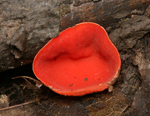
|
Scarlet Cup, Sarcoscypha austriaca These brightly coloured cup fungi are one of the first species to appear in early spring.
Photographed at Spring Garden on May 3, 2008 by Tom Preney.
|
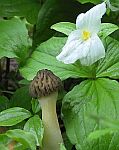
|
Half-free Morel, Morchella semilibera The lower edge of the cap is not attached to the stalk in this species which fruits about a week earlier than the Yellow Morel. The base of the stalk is often much thicker than the cap. Photographed at Ojibway, 7 May 2002.
|
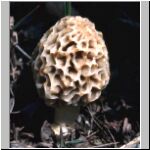
|
Yellow Morel, Morchella esculenta Morels fruit in early to mid May. They are one of the most sought after edible mushrooms in the Great Lakes region but in our area only small numbers can be found most years. Look for them in sandy woodlands, often near dying elms.
|
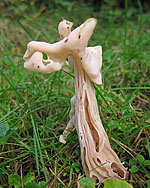
|
White Elfin Saddle, Helvella crispa An inedible creamy white mushroom with an irregular saddle-like cap and fluted stem.
Photographed in LaSalle, October 5, 2011.
|
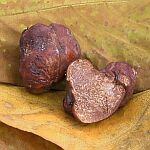
|
Cinnamon Truffle, Tuber rufum Truffles are seldom seen
since the fruiting bodies are produced underground. Their strong smell is
an adaptation for spore dispersal. Mice and other small mammals sniff out
these underground treats and then disperse the spores through their
droppings. The famous Black Truffle of Europe is a culinary delicacy that
can fetch over $2000 US per pound.
Photographed in Windsor on November 25, 2002.
|
|
BASIDIOMYCETES
|
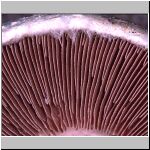
|
Meadow Mushroom, Agaricus campestris Large numbers of Meadow Mushrooms can often be found in pastures in September and October. This species is closely related to the supermarket/pizza topping mushroom, Agaricus biporus.
|
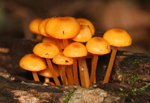
|
Orange Mycena, Mycena leaiana This common mushroom will be sure to catch your eye. The red gill edges are a key identification feature of this fungus.
Photographed at Ojibway on June 14, 2007 by Tom Preney.
|
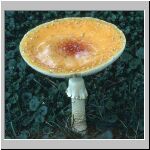
|
Fly Agaric, Amanita muscaria
The Fly Agaric is a common white mushroom with an orangish to red cap. This is the species illustrated in many fairy tales (it occurs both in North America and Europe). Many mushrooms in this genus are extremely poisonous.
|
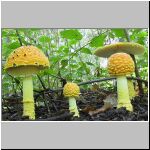
|
Yellow Patches, Amanita flavoconia Large numbers of this striking mushroom were found growing beneath Black Oaks in the fall of 2001.
Photographed at Ojibway on October 2, 2001.
|
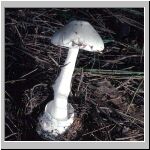
|
Destroying Angel, Amanita cf. virosa A relatively widespread species considered one of the most poisonous mushrooms in North America. Most Amanitas grow in close association with forest trees. The trees supply the fungus with food and the fungus provides phosphorus to the tree's roots. Neither would survive well without the other.
|
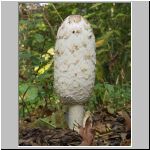
|
Shaggy Mane, Coprinus comatus The gills of the Shaggy Mane are packed together so tightly that the spores cannot be dispersed into the air. Instead the cap digests itself into an inky dark liquid that contains the spores and insects visiting the mushroom get the job of transporting the sticky spores to new locations. This fungus often fruits where the ground is hard packed such as along trails and roadsides.
Photographed at Ojibway on October 4, 2001.
|
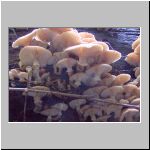
|
Honey Mushroom, Armillaria mellea The Honey Mushroom is very common at Ojibway, found growing on stumps and fallen logs. Freshly cut wood infected with the actively growing fungus glows in the dark. This fungus often kills trees that are weakened from other disease or injury.
|
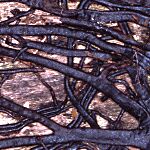
|
When a tree dies Honey Mushrooms send masses of black "shoestrings" up the trunk (just under the bark) to take advantage of this rich food source before the tree even falls. These shoestrings can also be sent through the soil to find other trees suitable for invasion.
|
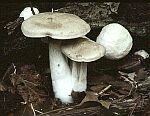
|
Aborted Entoloma (Hunter's Hearts), Entoloma abortivum This is another common fall mushroom at Ojibway. They are often parasitized by Honey Mushrooms, which causes the fruiting bodies to become deformed lumpy masses. Both normal and aborted forms are illustrated.
Photographed at Ojibway on September 24, 1986.
|
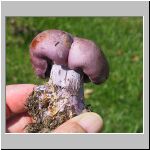
|
Blewit, Lepista (Clitocybe) nuda Blewits can be found in October once the weather becomes a bit cooler. Despite their bright bluish purple colour their squat stature makes them hard to spot amongst the fallen leaves.
Photographed at Ojibway on October 2, 2001.
|
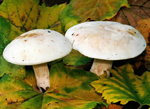
|
Flowery Blewits, Lepista (Clitocybe) irina A non-descript mushroom with large silky white caps and thick stalks. At times this mushroom can form fairy rings containing many individuals.
Photographed at Ojibway Park on October 20, 2009 by Tom Preney.
|
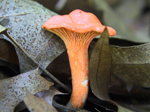
|
Red Chanterelle, Cantharrllus cinnabarinus Species from this family are possibly the worlds most sought after edible wild mushroom.
This species prefers open oak woodlands and can be found along trail sides.
Photographed at Ojibway Park on August 20, 2003 by Tom Preney
|
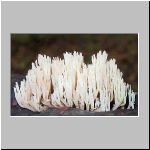
|
Crown Coral, Clavicorona pyxidata Clavicorona is a common summer fungus found on old rotten logs at Ojibway. Look for the distinctive "crown tips" of the branches. It has a hot peppery aftertaste but should you try a bite, be sure to spit out the piece and not swallow.
Photographed at Ojibway on September 23, 2001.
|
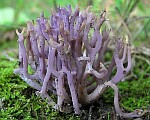
|
Violet-branched Coral, Clavulina amethystina Coral fungi such as this species are most often found in late summer and autumn growing on the ground.
Photographed in LaSalle on August 30 , 2004 by Tom Preney.
|
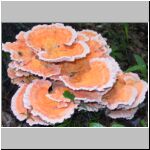
|
Chicken of the Woods or Sulphur Shelf, Laetiporus sulphureus The bright sulphur yellow and orange clusters of this large fungus can be found on living oaks and fallen logs in early autumn.
Photographed at Ojibway on August 23, 2001 by Tom Preney.
|
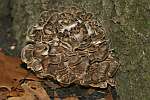
|
Hen of the Woods, Grifola frondosa This mushroom can be found at the base of oak trees in the park. The fruiting body obtains its nutrients from the living roots of the tree. This mushroom has been reported to weigh up to 50lbs or more but it can be easily overlooked among fallen leaves.
Photographed at Ojibway on October 16, 2010 by Tom Preney.
|
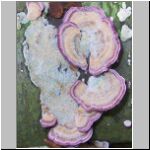
|
Violet-toothed Polypore, Trichaptum biforme Stumps and logs are sometimes covered with hundreds of overlapping caps of this common wood digesting fungus.
Photographed at Ojibway on September 23, 2001.
|
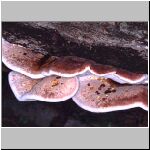
|
Late Fall (Resinous) Polypore Ischnoderma resinosum This large annual shelving bracket fungus has only been found locally on large maple logs. Polypores are important fungi because of their ability to digest wood which is made up of cellulose and lignin. White rot fungi (such as this species) primarily digest lignin leaving the whitish strands of cellulose behind, while brown rot fungi digest cellulose and leave the crumbling brown lignin behind.
|
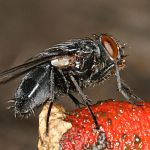
|
Elegant Stinkhorn, Mutinus elegans This unusual fungus produces a fetid odour that attracts flies and other insects. The olive spores are sticky and cling to the legs of visiting flies which then disperse the spores to new locations.
Photographed at Ojibway on October 18, 2006.
|
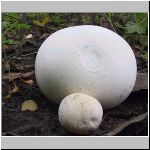
|
Giant Puffballs, Calvatia gigantea A giant of the mushroom world, this species can become so large as to be mistaken for a sheep lying in a field. Each puffball may contain billions of spores in a spongy mass with the texture of a marshmallow.
Photographed at Ojibway on September 23, 2001.
|
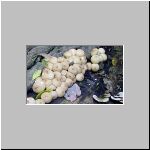
|
Pear-shaped Puffball, Lycoperdon pyriforme Large clumps of these small puffballs can be found on logs or growing in woodchips along park trails. Puffballs have a small pore on the top where the spores are released. When a large rain drop lands on a mature puffball the force is sufficient to release a "puff" of spores. The spongy filling helps the puffball regain its shape after being compressed.
|
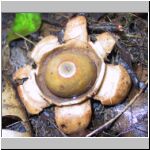
|
Collared Earthstar, Geastrum triplex Earthstars are related to puffballs but differ in the way the outer covering (peridium) splits open to produce a distinctive starlike pattern.
Photographed at Ojibway on August 23, 2001 by Tom Preney.
|
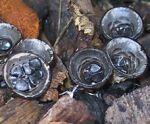
|
Dung Loving Bird's Nest, Cyathus stercoreus The spore capsules (eggs) can be thrown up to 2 metres from the fruiting body by the force of a single raindrop. Look for this 1 cm tall fungus among the woodchips used to refurbish park trails. Although often found in large numbers they are seldom noticed due to their small size.
Photographed at Ojibway on September 24, 2001.
|
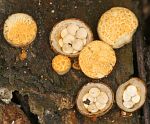
|
White-egg or Crucible Bird's Nest, Crucibulum laeve Another inconspicuous fungi found in woodchips along park trails. The Streaked Splash Cup, Cyathus striatus, can also be found in the park. It can be identified by the darker streaked lining of the cup.
Photographed at Ojibway on October 18, 2006.
|
Photographs © P.D. Pratt and Tom Preney

